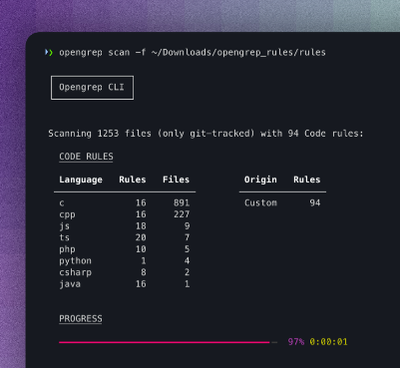
Security News
Opengrep Emerges as Open Source Alternative Amid Semgrep Licensing Controversy
Opengrep forks Semgrep to preserve open source SAST in response to controversial licensing changes.
@harvest-profit/doc-flux
Advanced tools
Flux/React framework for creating any document, just define a few DOM components to transform into the document.
Flux/React framework for creating any document, just define a few DOM components to transform into the document.
See an example of how to generate Spreadsheets https://github.com/humphreyja/sample-doc-flux-spreadsheets
To start, you must define a document. Think of this as the root. You will define a few document metadata options and specify which component it will render. Below I am using the DocFlux PDFS package to create a pdf that uses the Table component specified in the next section. documentSettings takes options specified in PDFMake document metadata docs.
import PropTypes from 'prop-types';
import { Document } from '@harvest-profit/doc-flux-pdfs';
import Table from './Table';
class TablePDF extends Document {
static propTypes = {
name: PropTypes.string.isRequired,
age: PropTypes.number.isRequired,
};
static styleSheet() {
return {
td: {
fontSize: 11,
marginTop: 2,
marginBottom: 2,
}
};
}
static documentSettings(props) {
return {
name: `People: ${props.name}`,
pageMargins: [30, 50, 30, 50],
pageOrientation: 'portrait',
};
}
static component = Table;
}
export default TablePDF;
The following is a sample component that will render a table. Notice, the tname tag. This is a special tag created from the DocFlux Spreadsheets package. It names the tab to People in excel. For PDFs, this will be ignored. NOTICE: For this to work, you must either import doc-flux as React or change the babel parser like the following:
import DocFlux from '@harvest-profit/doc-flux';
/** @jsx DocFlux.createElement */
//... rest of component file
It is easier to just specify it as React
import PropTypes from 'prop-types';
import React from '@harvest-profit/doc-flux';
import RandomRow from './RandomRow';
const Table = (props) => (
<table>
<tname>People</tname>
<thead>
<th>Name</th>
<th>Age</th>
</thead>
<tbody>
<tr>
<td>{props.name}</td>
<td>{props.age}</td>
</tr>
<RandomRow />
</tbody>
</table>
)
Table.propTypes = {
name: PropTypes.string.isRequired,
age: PropTypes.number.isRequired,
};
export default Table;
For testing, this uses a similar API to enzyme. You can shallow render the component (which only renders the component and not any child components). Then you can actively find or get text from the rendered component. You can find by tag name or component name.
Additionally, you can use at(index), first(), or last() on any find results.
import React, { shallow } from '@harvest-profit/doc-flux';
import Table from './Table';
import RandomRow from './RandomRow';
describe('<Table />', () => {
it('should render', () => {
const wrapper = shallow(
<Table
name="Jake"
age={100}
/>
);
expect(wrapper.find('tr').text()).toContain('Jake');
expect(wrapper.find('tr').first().text()).toContain('Jake');
});
it('should find the RandomRow component', () => {
const wrapper = shallow(
<Table
name="Jake"
age={100}
/>
);
expect(wrapper.find(RandomRow).length).toEqual(1);
});
});
Clone this repo, and begin committing changes. PRs are preferred over committing directly to master.
To run tests locally on your machine, run the following:
yarn run test
To preview documentation locally on your machine, run the following:
yarn run build-docs
After merging your pull request, consider updating the documentation with the following command:
yarn run publish-docs
To deploy a new version to NPM, bump the version number, commit/merge to master, and run the following:
yarn run clean
yarn run build
# Either NPM
npm publish
# Or Yarn, they do the same thing
yarn publish
This project is MIT licensed
FAQs
Flux/React framework for creating any document, just define a few DOM components to transform into the document.
The npm package @harvest-profit/doc-flux receives a total of 54 weekly downloads. As such, @harvest-profit/doc-flux popularity was classified as not popular.
We found that @harvest-profit/doc-flux demonstrated a not healthy version release cadence and project activity because the last version was released a year ago. It has 4 open source maintainers collaborating on the project.
Did you know?

Socket for GitHub automatically highlights issues in each pull request and monitors the health of all your open source dependencies. Discover the contents of your packages and block harmful activity before you install or update your dependencies.

Security News
Opengrep forks Semgrep to preserve open source SAST in response to controversial licensing changes.

Security News
Critics call the Node.js EOL CVE a misuse of the system, sparking debate over CVE standards and the growing noise in vulnerability databases.

Security News
cURL and Go security teams are publicly rejecting CVSS as flawed for assessing vulnerabilities and are calling for more accurate, context-aware approaches.